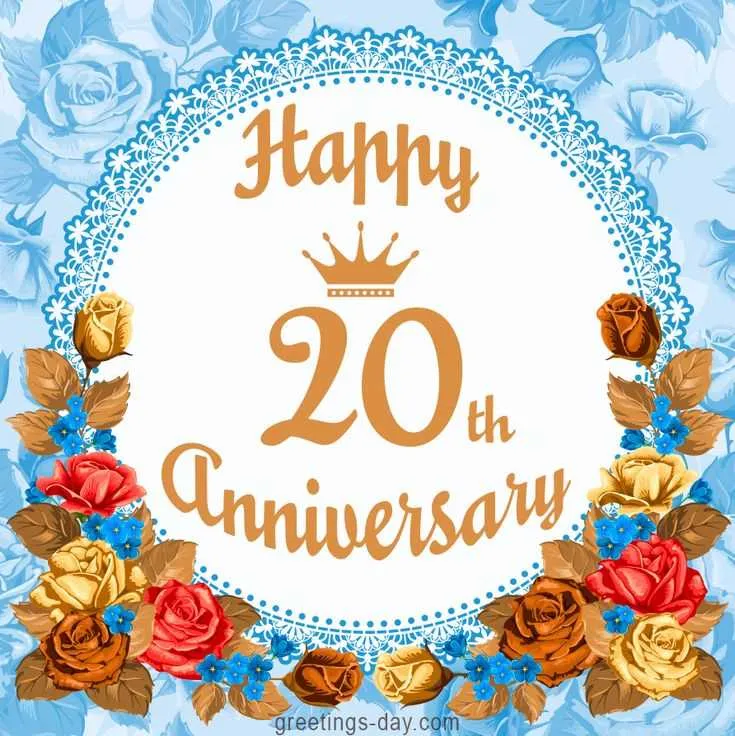Wishing You Joy Love and Lasting Memories on Your Special Twentieth Celebration

Send a message that reflects two decades of shared memories. Focus on specific moments you’ve experienced together–first trips, life milestones, or quiet routines that shaped your bond. Mention how these memories built the foundation of your connection.
Include a heartfelt thank-you. Highlight particular qualities your partner brings–patience, humor, support. Refer to moments when those traits made a difference. It helps personalize your message and shows genuine appreciation.
Offer a short vision of the future. One or two sentences are enough–mention something you’re both looking forward to, whether it’s a shared goal, an upcoming event, or just the next ordinary day spent together. This balances nostalgia with anticipation.
Close with sincerity. A simple, honest line like “I’m glad we chose each other” or “Here’s to everything we’ve built” carries more impact than poetic expressions. Keep it personal and real.
Happy 20th Anniversary Message
Choose words that reflect shared milestones, unique experiences, and growth. Mention a specific memory that defined the relationship–like the first trip abroad or the project you built together. Avoid vague compliments; focus on what makes your bond unique.
Use clear, direct language. For example: “You still make me laugh the same way you did in 2005” holds more meaning than general praise. Include a short note of appreciation tied to something the other person values. If they cherish tradition, reference your annual traditions; if they value humor, include an inside joke.
Close with a look forward. Instead of clichés, refer to a real plan, like a future getaway or a renovation you’ve both wanted. Keep it under 150 words for clarity and emotional punch.
Crafting a Personalized Note for a Spouse or Partner
Skip general compliments and mention something they did recently that made you feel seen–like how they remembered your favorite snack after a long day. Specific memories hit deeper than broad praise.
Use direct language. Replace “You’re amazing” with “You always find a way to make me laugh when I’m stressed.” That shift adds weight and clarity.
Include a private reference only you two understand. Whether it’s a shared joke, a nickname, or a phrase tied to a special trip, it brings intimacy into every line.
Stick to a clear structure: open with gratitude, highlight a personal trait you value, and finish with one wish for the next year together. This keeps the message focused and meaningful.
Handwriting the note adds texture–visually and emotionally. If you’re writing digitally, add a short handwritten line at the end and scan it in.
Choosing the Right Tone for Formal or Workplace Greetings
Opt for concise, respectful phrasing that acknowledges the occasion without sounding overly casual or too emotional. Begin with a direct congratulatory message, such as “Congratulations on reaching this remarkable 20-year milestone.” Avoid exclamation marks unless the workplace culture supports a more relaxed tone.
Use titles and full names where appropriate–especially when addressing executives or external partners. A message like “Wishing you continued success and growth as you celebrate this anniversary” maintains professionalism while expressing appreciation.
Maintain a balanced structure: open with recognition, follow with a brief compliment or reflection on their contributions, and close with forward-looking encouragement. For example: “Your dedication over the past two decades has made a lasting impact. Here’s to many more achievements ahead.”
Avoid slang, idioms, or overly enthusiastic language. Focus on clarity and relevance. Tailor the message to the recipient’s role or impact within the company rather than using generic praise.
Incorporating Shared Memories and Milestones in the Message
Begin with a specific reference to a memory that both of you often recall with a smile. This sets a personal tone and brings instant emotional connection.
- Mention the exact date or year of a significant event – your first trip together, buying your first home, or adopting a pet.
- Refer to challenges you faced together, but focus on what you achieved or learned from them.
- Include inside jokes or phrases that only the two of you understand. These tiny details create a sense of intimacy.
To highlight the growth of your relationship, list key moments that marked a shift – changing careers, moving cities, or expanding your family. This helps structure the message and shows clear progress over time.
- Use exact milestones rather than vague descriptions – for example, “The day we moved into the green house on 4th Street” instead of “When we moved in together.”
- If appropriate, include a quote from an old message, card, or conversation that still holds meaning.
Wrap the section by tying these moments to the present, showing how they shaped who you are together today. Keep the tone warm and conversational, letting shared experiences speak for themselves.